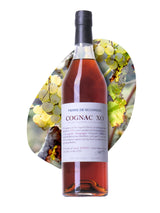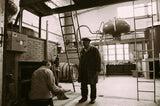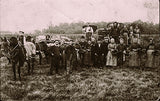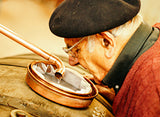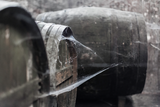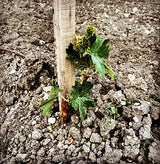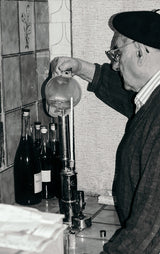

The late Pierre Ferrand in the distillery
You can FEEL the skill of a master when you visit a great distillery, the atmospheric accumulation over time of constant close attention to every detail.

One of the last estate cognacs. This is the harvest in the 1920s
Pierre’s cognacs are hand-distilled from grapes grown in the family’s small vineyard near Segonzac, home to some of Cognac’s finest grapes. The estate, La Nérolle, and the vineyard are in the heart of Cognac’s finest grand champagne soils. The Ferrand family tends the vines, harvests the grapes, crushes and makes distilling wine using wild yeasts, then distills the wines on two hand-operated potstills.

Traditional methods
Traditional methods mean hands-on work that gives you a deeper understanding of what you’re doing. You develop a non-verbal sense of what’s right or wrong with the process. You tune in. Some modern things are better: propane gives you way more control ove your distillation run than a wood fire, but the rush to cut costs and save time has essentially debased most modern commercial spirits production.

There are cognacs in the family’s cellars distilled by Pierre’s great-grandfather.
Aging is in standard 350-liter cognac barrels; theirs are Limousin oak. Relatively few of the barrels are new: the family believes in cognacs that are lightly oaked: oak as a backdrop to the complex and varied flavors and aromas so beautifully focused and enriched by distillation.

The finest cognacs come from the grande champagne district
Champagne means open countryside: soils so thin that the land is not forested. such soils are usually mineral (limestone) and produce grapes with high acidity, which distill into cognacs of deep focus that age well. Grapes that struggle to grow have wonderful flavor and complexity.

Knowledge, experience, and skill
All of this means very little absent the skills, talent, and knowledge of the distiller and cellar-master, knowledge and expertise handed from father to son to grandson: how best to tend grapes, the precise time to harvest, use of yeasts, modes of distillation, adjusting techniques to suit the wines of the current vintage, secrets of aging and blending specific to cognac distilled from the family’s grapes: this cannot be duplicated.


The late Pierre Ferrand in the distillery
You can FEEL the skill of a master when you visit a great distillery, the atmospheric accumulation over time of constant close attention to every detail.

One of the last estate cognacs. This is the harvest in the 1920s
Pierre’s cognacs are hand-distilled from grapes grown in the family’s small vineyard near Segonzac, home to some of Cognac’s finest grapes. The estate, La Nérolle, and the vineyard are in the heart of Cognac’s finest grand champagne soils. The Ferrand family tends the vines, harvests the grapes, crushes and makes distilling wine using wild yeasts, then distills the wines on two hand-operated potstills.

Traditional methods
Traditional methods mean hands-on work that gives you a deeper understanding of what you’re doing. You develop a non-verbal sense of what’s right or wrong with the process. You tune in. Some modern things are better: propane gives you way more control ove your distillation run than a wood fire, but the rush to cut costs and save time has essentially debased most modern commercial spirits production.

There are cognacs in the family’s cellars distilled by Pierre’s great-grandfather.
Aging is in standard 350-liter cognac barrels; theirs are Limousin oak. Relatively few of the barrels are new: the family believes in cognacs that are lightly oaked: oak as a backdrop to the complex and varied flavors and aromas so beautifully focused and enriched by distillation.

The finest cognacs come from the grande champagne district
Champagne means open countryside: soils so thin that the land is not forested. such soils are usually mineral (limestone) and produce grapes with high acidity, which distill into cognacs of deep focus that age well. Grapes that struggle to grow have wonderful flavor and complexity.

Knowledge, experience, and skill
All of this means very little absent the skills, talent, and knowledge of the distiller and cellar-master, knowledge and expertise handed from father to son to grandson: how best to tend grapes, the precise time to harvest, use of yeasts, modes of distillation, adjusting techniques to suit the wines of the current vintage, secrets of aging and blending specific to cognac distilled from the family’s grapes: this cannot be duplicated.
Pierre de Segonzac Cognac XO
_________________
Without exception, our goods are sold in the State of California, and title passes at purchase to the buyer in California. No representation is made as to the legal rights of anyone to ship to or import into any state other than California. The buyer is solely responsible for shipment to states outside California. By placing an order, the buyer authorizes Rarestill to act on his/her behalf to engage a common carrier to deliver his/her order to buyer.
Please read the information below carefully, especially if your purchase is a gift.
ALCOHOLIC BEVERAGES MAY BE SOLD AND DELIVERED ONLY TO PERSONS WHO ARE AT LEAST 21 YEARS OLD. IN PLACING YOUR ORDER, YOU REPRESENT TO US THAT YOU ARE AT LEAST 21 YEARS OLD AND THAT THE PERSON TO WHOM YOU ARE DIRECTING DELIVERY IS ALSO AT LEAST 21 YEARS OLD.
When your goods are delivered, the person receiving delivery may be required to show identification proving that he or she is at least 21 years old.
All sales made on this website will be deemed to have taken place in Ukiah, CA, and sales taxes will be assessed based on that location.


The late Pierre Ferrand in the distillery
You can FEEL the skill of a master when you visit a great distillery, the atmospheric accumulation over time of constant close attention to every detail.

One of the last estate cognacs. This is the harvest in the 1920s
Pierre’s cognacs are hand-distilled from grapes grown in the family’s small vineyard near Segonzac, home to some of Cognac’s finest grapes. The estate, La Nérolle, and the vineyard are in the heart of Cognac’s finest grand champagne soils. The Ferrand family tends the vines, harvests the grapes, crushes and makes distilling wine using wild yeasts, then distills the wines on two hand-operated potstills.

Traditional methods
Traditional methods mean hands-on work that gives you a deeper understanding of what you’re doing. You develop a non-verbal sense of what’s right or wrong with the process. You tune in. Some modern things are better: propane gives you way more control ove your distillation run than a wood fire, but the rush to cut costs and save time has essentially debased most modern commercial spirits production.

There are cognacs in the family’s cellars distilled by Pierre’s great-grandfather.
Aging is in standard 350-liter cognac barrels; theirs are Limousin oak. Relatively few of the barrels are new: the family believes in cognacs that are lightly oaked: oak as a backdrop to the complex and varied flavors and aromas so beautifully focused and enriched by distillation.

The finest cognacs come from the grande champagne district
Champagne means open countryside: soils so thin that the land is not forested. such soils are usually mineral (limestone) and produce grapes with high acidity, which distill into cognacs of deep focus that age well. Grapes that struggle to grow have wonderful flavor and complexity.

Knowledge, experience, and skill
All of this means very little absent the skills, talent, and knowledge of the distiller and cellar-master, knowledge and expertise handed from father to son to grandson: how best to tend grapes, the precise time to harvest, use of yeasts, modes of distillation, adjusting techniques to suit the wines of the current vintage, secrets of aging and blending specific to cognac distilled from the family’s grapes: this cannot be duplicated.


